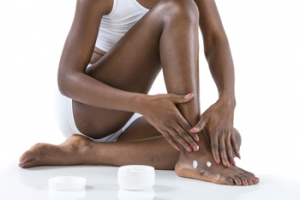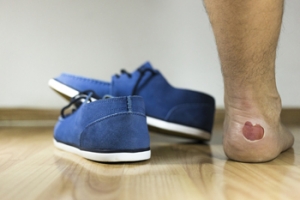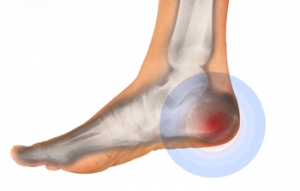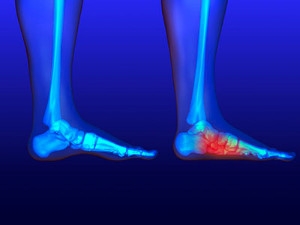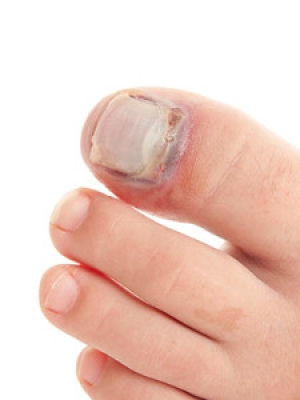Super User
Taking Care of Your Feet
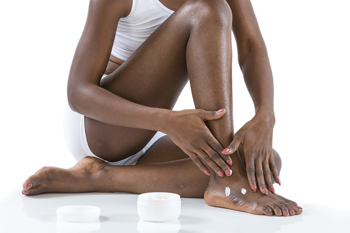 Feet go through a lot of wear and tear over the course of one’s life, so it's important to take small steps to ensure their overall health. Wearing comfortable shoes is key when trying to keep your feet healthy. Shoes that are tight or lack support can lead to various types of uncomfortable foot conditions. Some of these conditions include bunions, Morton’s neuroma, ingrown toenails, and blisters. Daily walking routines help keep the muscles in your feet active, flexible, and strong, which could prevent fallen arches or other complications later on in life. Most of the time, feet spend majority of the day confined to a shoe, which can trap moisture and bacteria. Cleaning your feet daily and wearing socks helps to prevent bacterial and fungal infections. Moisturizing your feet also contributes to their health by preventing dry, cracked, or scaly skin. If you would like any additional information on how to care for your feet, then it is suggested you speak with a podiatrist.
Feet go through a lot of wear and tear over the course of one’s life, so it's important to take small steps to ensure their overall health. Wearing comfortable shoes is key when trying to keep your feet healthy. Shoes that are tight or lack support can lead to various types of uncomfortable foot conditions. Some of these conditions include bunions, Morton’s neuroma, ingrown toenails, and blisters. Daily walking routines help keep the muscles in your feet active, flexible, and strong, which could prevent fallen arches or other complications later on in life. Most of the time, feet spend majority of the day confined to a shoe, which can trap moisture and bacteria. Cleaning your feet daily and wearing socks helps to prevent bacterial and fungal infections. Moisturizing your feet also contributes to their health by preventing dry, cracked, or scaly skin. If you would like any additional information on how to care for your feet, then it is suggested you speak with a podiatrist.
Everyday foot care is very important to prevent infection and other foot ailments. If you need your feet checked, contact Dr. Anna Petrov from Family Foot & Ankle Care. Our doctor can provide the care you need to keep you pain-free and on your feet.
Everyday Foot Care
Often, people take care of their bodies, face and hair more so than they do for their feet. But the feet are a very important aspect of our bodies, and one that we should pay more attention to. Without our feet, we would not be able to perform most daily tasks.
It is best to check your feet regularly to make sure there are no new bruises or cuts that you may not have noticed before. For dry feet, moisturizer can easily be a remedy and can be applied as often as necessary to the affected areas. Wearing shoes that fit well can also help you maintain good foot health, as well as making it easier to walk and do daily activities without the stress or pain of ill-fitting shoes, high heels, or even flip flops. Wearing clean socks with closed shoes is important to ensure that sweat and bacteria do not accumulate within the shoe. Clean socks help to prevent Athlete’s foot, fungi problems, bad odors, and can absorb sweat.
If you have any questions please feel free to contact one of our offices located in Wheeling and Chicago, IL . We offer the newest diagnostic and treatment technologies for all your foot and ankle needs.
Read more about Every Day Foot CareEvery Day Foot Care
Our feet are important in our everyday lives. The problem is that we tend to neglect them. When this becomes a habit, it can cause significant trouble. Ignoring foot problems can mean pain, limited mobility, and expensive doctor's visits. On the other hand, if feet are cared for and looked after regularly, they will perform without pain or complication.
Routine hygiene is the most basic way to care for the feet. Wash and dry them thoroughly daily. Remember to get between the toes and keep the toenails trimmed and short. If the feet feel dry or there are signs of dryness or cracking, use a moisturizer designed for the feet.
When using moisturizer on the feet, try to avoid applying between the toes. If cream or lotion sits too long, they can cause fungal and bacterial growth. When moisturizer is used between the toes, it can also cause the skin to soften too much.
Shoes are also an important aspect of foot care. When one is picking out shoes, make sure they are the correct size. Shoes need to be snug, but not too tight. On the other hand, if shoes are too loose they can cause foot problems as well. It is highly recommended that shopping for new shoes be done later in the day. The reason for this is that the feet will have settled and swelled to their full size by then. To keep your feet at their most healthy, avoid wearing high heels or flip flops too often. Instead, choose shoes that are good for your feet. Good shoes pad the soles of your feet and support the arches and ankles.
Socks should also be worn daily with closed-toe shoes. They may feel hot during the summer months, but they absorb sweat and moisture off the feet. Without socks, the build-up of sweat in a closed-toe shoe can cause fungal problems and athlete's foot.
The best thing to remember in every day foot care is that shoes do make a difference. If you spend a lot of time on your feet, make sure that your shoes show no signs of wear. Shoes should offer ample support for the arches and the overall foot. Additionally, try to make foot cleaning and maintenance a daily habit. If you keep these things in mind, your feet will stay healthy and safe.
The Three Stages of Ingrown Toenails
 Ingrown toenails are uncomfortable and can sometimes make it painful to walk. Common causes for this condition include ill-fitting shoes, injury, excessively sweaty feet, and thick or curved nails. Once they have started to form, ingrown toenails can go through three stages. Stage 1 begins with the initial inflammation and is followed by moderate pain, swelling, redness, and visible fluid accumulation. Stage 2 occurs if the symptoms begin to worsen. Signs that the nail is entering stage 2 are increased pain and pus discharge from the wound. Stage 3 is the most severe form of an ingrown toenail and requires medical attention in order to be treated. In stage 3, new tissue can form over the wound, which can easily intensify the infection. It’s important to begin treating an ingrown toenail as soon as you notice any symptoms, so you can avoid progression into stage 3. If you have an ingrown toenail, it is recommended you consult with a podiatrist to learn about treatment options.
Ingrown toenails are uncomfortable and can sometimes make it painful to walk. Common causes for this condition include ill-fitting shoes, injury, excessively sweaty feet, and thick or curved nails. Once they have started to form, ingrown toenails can go through three stages. Stage 1 begins with the initial inflammation and is followed by moderate pain, swelling, redness, and visible fluid accumulation. Stage 2 occurs if the symptoms begin to worsen. Signs that the nail is entering stage 2 are increased pain and pus discharge from the wound. Stage 3 is the most severe form of an ingrown toenail and requires medical attention in order to be treated. In stage 3, new tissue can form over the wound, which can easily intensify the infection. It’s important to begin treating an ingrown toenail as soon as you notice any symptoms, so you can avoid progression into stage 3. If you have an ingrown toenail, it is recommended you consult with a podiatrist to learn about treatment options.
Ingrown toenails may initially present themselves as a minor discomfort, but they may progress into an infection in the skin without proper treatment. For more information about ingrown toenails, contact Dr. Anna Petrov of Family Foot & Ankle Care. Our doctor can provide the care you need to keep you pain-free and on your feet.
Ingrown Toenails
Ingrown toenails are caused when the corner or side of a toenail grows into the soft flesh surrounding it. They often result in redness, swelling, pain, and in some cases, infection. This condition typically affects the big toe and may recur if it is not treated properly.
Causes
- Improper toenail trimming
- Genetics
- Improper shoe fitting
- Injury from pedicures or nail picking
- Abnormal gait
- Poor hygiene
You are more likely to develop an ingrown toenail if you are obese, have diabetes, arthritis, or have any fungal infection in your nails. Additionally, people who have foot or toe deformities are at a higher risk of developing an ingrown toenail.
Symptoms
Some symptoms of ingrown toenails are redness, swelling, and pain. In rare cases, there may be a yellowish drainage coming from the nail.
Treatment
Ignoring an ingrown toenail can have serious complications. Infections of the nail border can progress to a deeper soft-tissue infection, which can then turn into a bone infection. You should always speak with your podiatrist if you suspect you have an ingrown toenail, especially if you have diabetes or poor circulation.
If you have any questions, please feel free to contact one of our offices located in Wheeling and Chicago, IL . We offer the newest diagnostic and treatment technologies for all your foot care needs.
What Is a Blister?
 Patients who have suffered from blisters are familiar with the pain and discomfort they may cause. They may develop as a result of increased friction on a portion of the skin, which may come from wearing shoes or socks that fit improperly. When the skin becomes exposed, a blister will form as part of the body’s natural defense mechanism. This consists of a pocket of fluid which protects the affected area of skin. Additional reasons why blisters may develop may include allergic reactions to a bee sting or insect bite, or neuropathy which may originate from diabetes. If neuropathy is present, it may cause the patient to be unaware of existing blisters, and this may be a result of the inability to sense discomfort. When new skin begins to grow under the blister, it will generally drain on its own. If you have a blister on your foot that has become infected, it is suggested to speak to a podiatrist who can properly assist you in obtaining the correct treatment.
Patients who have suffered from blisters are familiar with the pain and discomfort they may cause. They may develop as a result of increased friction on a portion of the skin, which may come from wearing shoes or socks that fit improperly. When the skin becomes exposed, a blister will form as part of the body’s natural defense mechanism. This consists of a pocket of fluid which protects the affected area of skin. Additional reasons why blisters may develop may include allergic reactions to a bee sting or insect bite, or neuropathy which may originate from diabetes. If neuropathy is present, it may cause the patient to be unaware of existing blisters, and this may be a result of the inability to sense discomfort. When new skin begins to grow under the blister, it will generally drain on its own. If you have a blister on your foot that has become infected, it is suggested to speak to a podiatrist who can properly assist you in obtaining the correct treatment.
Blisters are prone to making everyday activities extremely uncomfortable. If your feet are hurting, contact Dr. Anna Petrov of Family Foot & Ankle Care. Our doctor can provide the care you need to keep you pain-free and on your feet.
Foot Blisters
Foot blisters develop as a result of constantly wearing tight or ill-fitting footwear. This happens due to the constant rubbing from the shoe, which can often lead to pain.
What Are Foot Blisters?
A foot blister is a small fluid-filled pocket that forms on the upper-most layer of the skin. Blisters are filled with clear fluid and can lead to blood drainage or pus if the area becomes infected.
How Do Blisters Form?
Blisters on the feet are often the result of constant friction of skin and material, usually by shoe rubbing. Walking in sandals, boots, or shoes that don’t fit properly for long periods of time can result in a blister. Having consistent foot moisture and humidity can easily lead to blister formation.
Prevention & Treatment
It is important to properly care for the affected area in order to prevent infection and ease the pain. Do not lance the blister and use a Band-Aid to provide pain relief. Also, be sure to keep your feet dry and wear proper fitting shoes. If you see blood or pus in a blister, seek assistance from a podiatrist.
If you have any questions, please feel free to contact one of our offices located in Wheeling and Chicago, IL . We offer the newest diagnostic and treatment technologies for all your foot care needs.
Causes of Heel Pain
 Many patients suffer from heel pain, and there may be several reasons why this may occur. These may include injuries to the foot that involves the heel, chronic conditions such as plantar fasciitis, bruises or stress fractures. Achilles tendonitis may develop as result of overuse, which may happen while participating in sporting activities. A heel pad bruise may occur as a result of wearing shoes that do not have adequate cushioning. It may also occur from falling from a high distance and landing on the heel. A condition that is known as haglund’s syndrome may occur if a bony protrusion develops on the back of the heel as it rubs against shoes that are stiff. Symptoms of this may include pain in the heel area of the foot, and possible swelling. If you are experiencing any type of heel pain, it is strongly suggested that you seek the counsel of a podiatrist who can properly diagnose and treat heel pain.
Many patients suffer from heel pain, and there may be several reasons why this may occur. These may include injuries to the foot that involves the heel, chronic conditions such as plantar fasciitis, bruises or stress fractures. Achilles tendonitis may develop as result of overuse, which may happen while participating in sporting activities. A heel pad bruise may occur as a result of wearing shoes that do not have adequate cushioning. It may also occur from falling from a high distance and landing on the heel. A condition that is known as haglund’s syndrome may occur if a bony protrusion develops on the back of the heel as it rubs against shoes that are stiff. Symptoms of this may include pain in the heel area of the foot, and possible swelling. If you are experiencing any type of heel pain, it is strongly suggested that you seek the counsel of a podiatrist who can properly diagnose and treat heel pain.
Many people suffer from bouts of heel pain. For more information, contact Dr. Anna Petrov of Family Foot & Ankle Care. Our doctor can provide the care you need to keep you pain-free and on your feet.
Causes of Heel Pain
Heel pain is often associated with plantar fasciitis. The plantar fascia is a band of tissues that extends along the bottom of the foot. A rip or tear in this ligament can cause inflammation of the tissue.
Achilles tendonitis is another cause of heel pain. Inflammation of the Achilles tendon will cause pain from fractures and muscle tearing. Lack of flexibility is also another symptom.
Heel spurs are another cause of pain. When the tissues of the plantar fascia undergo a great deal of stress, it can lead to ligament separation from the heel bone, causing heel spurs.
Why Might Heel Pain Occur?
- Wearing ill-fitting shoes
- Wearing non-supportive shoes
- Weight change
- Excessive running
Treatments
Heel pain should be treated as soon as possible for immediate results. Keeping your feet in a stress-free environment will help. If you suffer from Achilles tendonitis or plantar fasciitis, applying ice will reduce the swelling. Stretching before an exercise like running will help the muscles. Using all these tips will help make heel pain a condition of the past.
If you have any questions please contact one of our offices located in Wheeling and Chicago, IL . We offer the newest diagnostic and treatment technologies for all your foot and ankle needs.
Treating Plantar Fasciitis with Shockwave Therapy
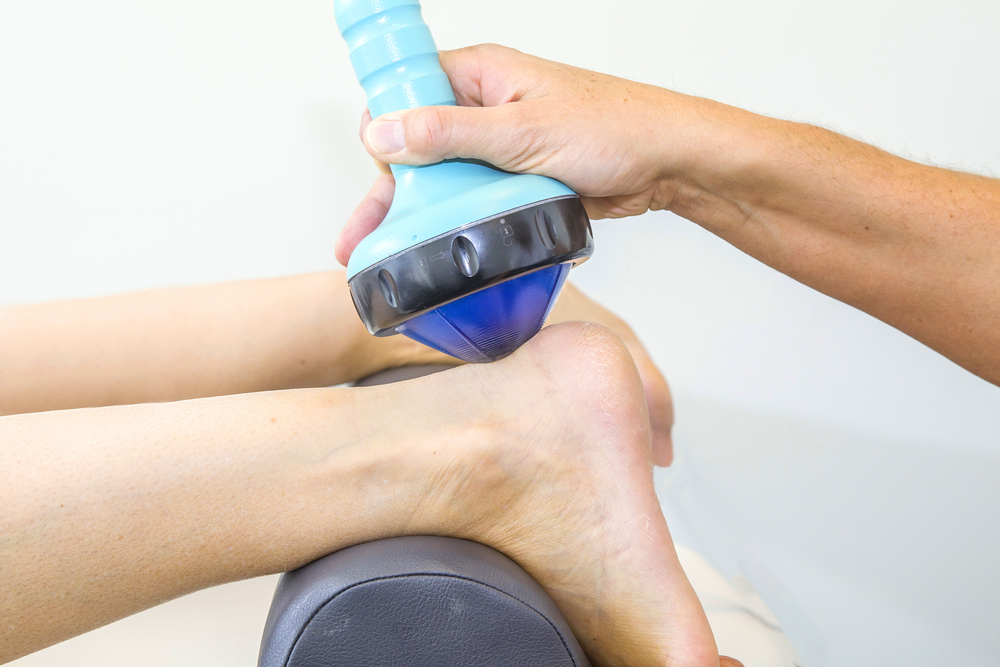 Plantar fasciitis is a common foot condition that affects the heel and causes striking pain outward. This condition occurs when the connective tissue, plantar fascia, which runs along the underside of the foot, is injured or inflamed. It is most common in those who participate in activities like running that cause repetitive impact on the feet. Most of the time it can be treated with simple remedies that do not require surgery, but some severe cases require further action. Surgery is rare, but can be invasive, so many doctors are turning to alternative therapies. Shockwave therapy helps to trigger the repair and regrowth of the injured nerve. The plantar fascia is located in an area of the foot that does not receive much blood flow, which impedes on the its ability to heal itself. Shockwave therapy helps to pull blood to the plantar fascia to facilitate repairing the nerve. If you have plantar fasciitis, it is highly recommended to speak with a podiatrist about your treatment options.
Plantar fasciitis is a common foot condition that affects the heel and causes striking pain outward. This condition occurs when the connective tissue, plantar fascia, which runs along the underside of the foot, is injured or inflamed. It is most common in those who participate in activities like running that cause repetitive impact on the feet. Most of the time it can be treated with simple remedies that do not require surgery, but some severe cases require further action. Surgery is rare, but can be invasive, so many doctors are turning to alternative therapies. Shockwave therapy helps to trigger the repair and regrowth of the injured nerve. The plantar fascia is located in an area of the foot that does not receive much blood flow, which impedes on the its ability to heal itself. Shockwave therapy helps to pull blood to the plantar fascia to facilitate repairing the nerve. If you have plantar fasciitis, it is highly recommended to speak with a podiatrist about your treatment options.
Shockwave therapy is a treatment commonly used to treat various injuries and conditions, particularly plantar fasciitis in the feet. To learn more, consult with Dr. Anna Petrov from Family Foot & Ankle Care. Our doctor can provide the care you need to keep you pain-free and on your feet.
Shockwave Therapy
Shockwave therapy is a new treatment option designed to treat bone conditions such as tennis elbow, shoulder pain, and others. Shockwave therapy uses high intensity sound waves that are directed to the affected tissues of the body with pinpoint accuracy. The effects are very beneficial, leading to a production of collagen fibers, eliminating inflammation.
Who Benefits from Shockwave?
Shockwave is recommended for patients suffering from heel pain and associated problems. Heel pain is a common condition which can be caused by obesity, overexertion, and spending a substantial amount of time on hard floors with your feet exposed and unsupported.
Fast and Easy
The therapy is actually a simple process that can leave patients feeling better the very next day. Shockwave therapy is not as dramatic as it sounds. It enables more blood flow to effected areas, addressing the source of the problem and allowing treatment to last for a long time.
Treatment & Recovery Time
Shockwave treatment will enable your feet to recover quickly. This is especially important since surgery is not required. It is cost effective and does not require the use of anesthesia. This treatment is a better option to surgery, since it is proven safe.
If you have any questions, please feel free to contact one of our offices located in Wheeling and Chicago, IL . We offer the newest diagnostic and treatment technologies for all your foot and ankle needs.
Shockwave Therapy
Extracorporeal Shockwave Therapy (ESWT) is an alternative treatment method that is used for bone and soft tissue disorders in the foot and ankle. EWST is a noninvasive option for pain relief and it was originally created to help dissolve kidney stones. This therapy works by focusing impulses to target the area in pain. This method has been proven to show a reduction in the amount of nerve fibers that transmit painful impulses, which leads to a reduction in pain. Shockwave therapy can also expedite the tissue which would, in turn, increase the amount of new blood vessels that are formed.
Conditions that can be treated with shockwave therapy include Achilles pain and heel pain. People with plantar fasciitis may opt for this therapy and the results are usually great after 18 months. Additionally, this method can also be used to treat fractures that have failed to heal correctly. Anesthesia is not required to perform this treatment. It usually is not painful, but it can be uncomfortable.
The duration of treatment sessions usually lasts 5-15 minutes each. This procedure is safe since there is no risk of infection from wound complications, if you are looking to try shockwave therapy to heal plantar fasciitis, it may take 3-4 sessions to start working. After treatment, patients typically notice a dull pain in the area which was treated. However, this pain rarely lasts more than 24 hours.
Nevertheless, there are pros and cons that come along with Shockwave Therapy. The most obvious pro is that this treatment is noninvasive, meaning surgery will not be required. Another upside is that there have been very little complications that have been found with this procedure. On the other hand, those who opt for surgery are at risk for continued pain, wound problems, and infections. The biggest con for ESWT is that it is very expensive; it typically costs around $1,000 before insurance. Another con is that the effectiveness of the treatment is questionable. Usually, if this treatment is helpful, the difference is small.
If you are curious about Shockwave Therapy, you should talk to your podiatrist to see if this treatment method is right for you. At times, patients will find that there are other treatment options that are more efficient for their individual cases.
Different Types of Flat Feet
 The medical term given to a condition where there is an absence of the arch in the foot is referred to as flat feet or fallen arches. Research has shown the majority of babies are born with flat feet, and the arch will typically develop as walking begins. As this occurs, the muscles and tendons in the feet generally become stronger and this may initiate the development of the arch. There are different types of flat feet, and the most common is known as flexible flat foot. This is apparent when the arch is visible as the foot is held up and disappears when placed on the ground. Additionally, this condition may be caused by a short Achilles tendon, which may cause the heel to lift sooner than it should as walking or running occurs. The causes of flat feet involve the bones and tissues in the feet. If an injury should occur, damage to the arch may cause flat feet to occur. If you feel you have this condition and are experiencing any type of pain as a result of this, it is suggested to speak to a podiatrist who can properly treat this ailment.
The medical term given to a condition where there is an absence of the arch in the foot is referred to as flat feet or fallen arches. Research has shown the majority of babies are born with flat feet, and the arch will typically develop as walking begins. As this occurs, the muscles and tendons in the feet generally become stronger and this may initiate the development of the arch. There are different types of flat feet, and the most common is known as flexible flat foot. This is apparent when the arch is visible as the foot is held up and disappears when placed on the ground. Additionally, this condition may be caused by a short Achilles tendon, which may cause the heel to lift sooner than it should as walking or running occurs. The causes of flat feet involve the bones and tissues in the feet. If an injury should occur, damage to the arch may cause flat feet to occur. If you feel you have this condition and are experiencing any type of pain as a result of this, it is suggested to speak to a podiatrist who can properly treat this ailment.
Flatfoot is a condition many people suffer from. If you have flat feet, contact Dr. Anna Petrov from Family Foot & Ankle Care. Our doctor will treat your foot and ankle needs.
What Are Flat Feet?
Flatfoot is a condition in which the arch of the foot is depressed and the sole of the foot is almost completely in contact with the ground. About 20-30% of the population generally has flat feet because their arches never formed during growth.
Conditions & Problems:
Having flat feet makes it difficult to run or walk because of the stress placed on the ankles.
Alignment – The general alignment of your legs can be disrupted, because the ankles move inward which can cause major discomfort.
Knees – If you have complications with your knees, flat feet can be a contributor to arthritis in that area.
Symptoms
- Pain around the heel or arch area
- Trouble standing on the tip toe
- Swelling around the inside of the ankle
- Flat look to one or both feet
- Having your shoes feel uneven when worn
Treatment
If you are experiencing pain and stress on the foot you may weaken the posterior tibial tendon, which runs around the inside of the ankle.
If you have any questions please feel free to contact one of our offices located in Wheeling and Chicago, IL . We offer the newest diagnostic and treatment technologies for all your foot and ankle needs.
Flatfoot
Flatfoot is a foot disorder that is not as straightforward as many people believe. Various types of flatfoot exist, each with their own varying deformities and symptoms. The partial or total collapse of the arch, however, is a characteristic common to all types of flatfoot. Other signs of flatfoot include:
- “Toe drift,” or the pointing outward of the toes and the front part of the foot
- The tilting outward of the heel and the tilting inward of the ankle
- The lifting of the heel off the ground earlier when walking due to a tight Achilles tendon
- Hammertoes
- Bunions
One of the most common types of flatfoot is flexible flatfoot. This variation usually starts in childhood and progresses as one ages into adulthood. Flexible flatfoot presents as a foot that is flat when standing, or weight-bearing. When not standing, the arch returns. Symptoms of flexible flatfoot include:
- Pain located in the heel, arch, ankle, or along the outside of the foot
- Overpronation, or an ankle that rolls in
- Shin splint, or pain along the shin bone
- General foot aches or fatigue
- Pain located in the lower back, hip, or knee
Your podiatrist will most likely diagnose flatfoot by examining your feet when you stand and sit. X-rays may be taken to define the severity and help determine the treatment option best for your condition. Nonsurgical treatments can include activity modification, weight loss, orthotics, immobilization, medications, physical therapy, shoe modifications, and ankle foot orthoses (AFO) devices. If nonsurgical methods prove ineffective, surgery may be considered. Multiple surgical procedures can correct flatfoot; and depending on your specific condition, one may be selected alone or combined with other techniques to ensure optimal results.
How a Broken Toe Is Diagnosed
 There are several ways a broken toe can happen. These may include a sudden fracture by dropping a heavy object on your toes, stubbing your toe, or having a stress fracture gradually occur. Noticeable symptoms of a broken toe may include severe pain, discomfort, swelling, and many patients may see signs of bruising beginning to appear. In severe fractures, the toe may look crooked, and the ability to walk may be hindered. Once a proper diagnosis confirms the toe is broken, which typically happens when an X-ray is performed, the correct course of treatment can commence. It may be beneficial to elevate your foot, and this may aid in reducing a portion of the swelling, in addition to wearing a shoe with a stiff sole that can provide maximum support. If you have broken your toe, it is suggested that you speak to a podiatrist who can properly guide you through the healing process.
There are several ways a broken toe can happen. These may include a sudden fracture by dropping a heavy object on your toes, stubbing your toe, or having a stress fracture gradually occur. Noticeable symptoms of a broken toe may include severe pain, discomfort, swelling, and many patients may see signs of bruising beginning to appear. In severe fractures, the toe may look crooked, and the ability to walk may be hindered. Once a proper diagnosis confirms the toe is broken, which typically happens when an X-ray is performed, the correct course of treatment can commence. It may be beneficial to elevate your foot, and this may aid in reducing a portion of the swelling, in addition to wearing a shoe with a stiff sole that can provide maximum support. If you have broken your toe, it is suggested that you speak to a podiatrist who can properly guide you through the healing process.
A broken toe can be very painful and lead to complications if not properly fixed. If you have any concerns about your feet, contact Dr. Anna Petrov from Family Foot & Ankle Care. Our doctor will treat your foot and ankle needs.
What to Know About a Broken Toe
Although most people try to avoid foot trauma such as banging, stubbing, or dropping heavy objects on their feet, the unfortunate fact is that it is a common occurrence. Given the fact that toes are positioned in front of the feet, they typically sustain the brunt of such trauma. When trauma occurs to a toe, the result can be a painful break (fracture).
Symptoms of a Broken Toe
- Throbbing pain
- Swelling
- Bruising on the skin and toenail
- The inability to move the toe
- Toe appears crooked or disfigured
- Tingling or numbness in the toe
Generally, it is best to stay off of the injured toe with the affected foot elevated.
Severe toe fractures may be treated with a splint, cast, and in some cases, minor surgery. Due to its position and the pressure it endures with daily activity, future complications can occur if the big toe is not properly treated.
If you have any questions please feel free to contact one of our offices located in Wheeling and Chicago, IL . We offer the newest diagnostic and treatment technologies for all your foot and ankle needs.



